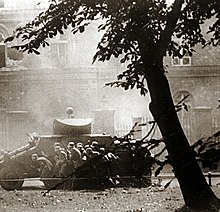

| Steyr ADGZ | |
|---|---|

ADGZ in 1936
| |
| Type | Armored car |
| Place of origin | Austria |
| Service history | |
| Used by | Austria Nazi Germany Free City of Danzig Independent State of Croatia |
| Wars | World War II |
| Production history | |
| Designer | Steyr |
| Designed | 1934-1935 |
| Manufacturer | Steyr |
| Produced | 1935-1941 |
| No. built | 52 |
| Specifications | |
| Mass | 12 tons |
| Length | 6.26 m (20 ft 6 in) |
| Width | 2.16 m (7 ft 1 in) |
| Height | 2.56 m (8 ft 5 in) |
| Crew | 6 |
| Armor | 11 mm (0.43 in) |
Main | 20mm KwK 35 L/45 (with 100 rounds) or 45 mm wz. 1932 (19-K) (T-26 model 1933 turret) |
Secondary | 3 x 7.92mm MG34 or 2 x 7.92mm MG34 and 1 x DT machine gun |
| Engine | Austro-Daimler M612, 6-cylinder, 12 litre 150 hp (110 kW) |
| Suspension | wheel 8×4 |
Operational | 450 km (280 mi) |
| Maximum speed | 70 km/h (43 mph) |
The Steyr ADGZ was an Austrian heavy armored car used during World War II. It was originally designed for the Austrian Army (designated as the "M35 Mittlerer Panzerwagen") in 1934, and delivered in 1935–1937.

The Austrian army was using the ADGZ armored car at the time of the Anschluss, with 12 being used by the army and 15 by police. The Germans also employed the vehicles for police work, with some taken by the Waffen-SS and utilized on the Eastern Front, as well as in the Balkans for anti-partisan activity and other purposes.
The SS ordered an additional 25 ADGZ armored cars, which were delivered in 1942. An interesting feature of the vehicle was that there was no "rear"; either end was capable of driving the unit.
As part of the initial operations of the Invasion of Poland, the SS Heimwehr Danzig used three ADGZ armored cars during the attack on the Polish Post Office in Danzig, but one was lost during the battle. Some ADGZs were also supplied to the Army of the Independent State of Croatia.[1]
|
| ||
|---|---|---|
| Tanks |
| |
| Self-propelled artillery |
| |
| Assault guns |
| |
| Tank destroyers (Panzerjäger, Jagdpanzer) |
| |
| Half-tracks |
| |
| Armored cars |
| |
| Self-propelled anti-aircraft guns |
| |
| Demolition vehicles |
| |
| Experimental vehicles, prototypes |
| |
| Proposed designs |
| |
| Designations |
| |
German armored fighting vehicle production during World War II | ||
This military vehicle article is a stub. You can help Wikipedia by expanding it. |